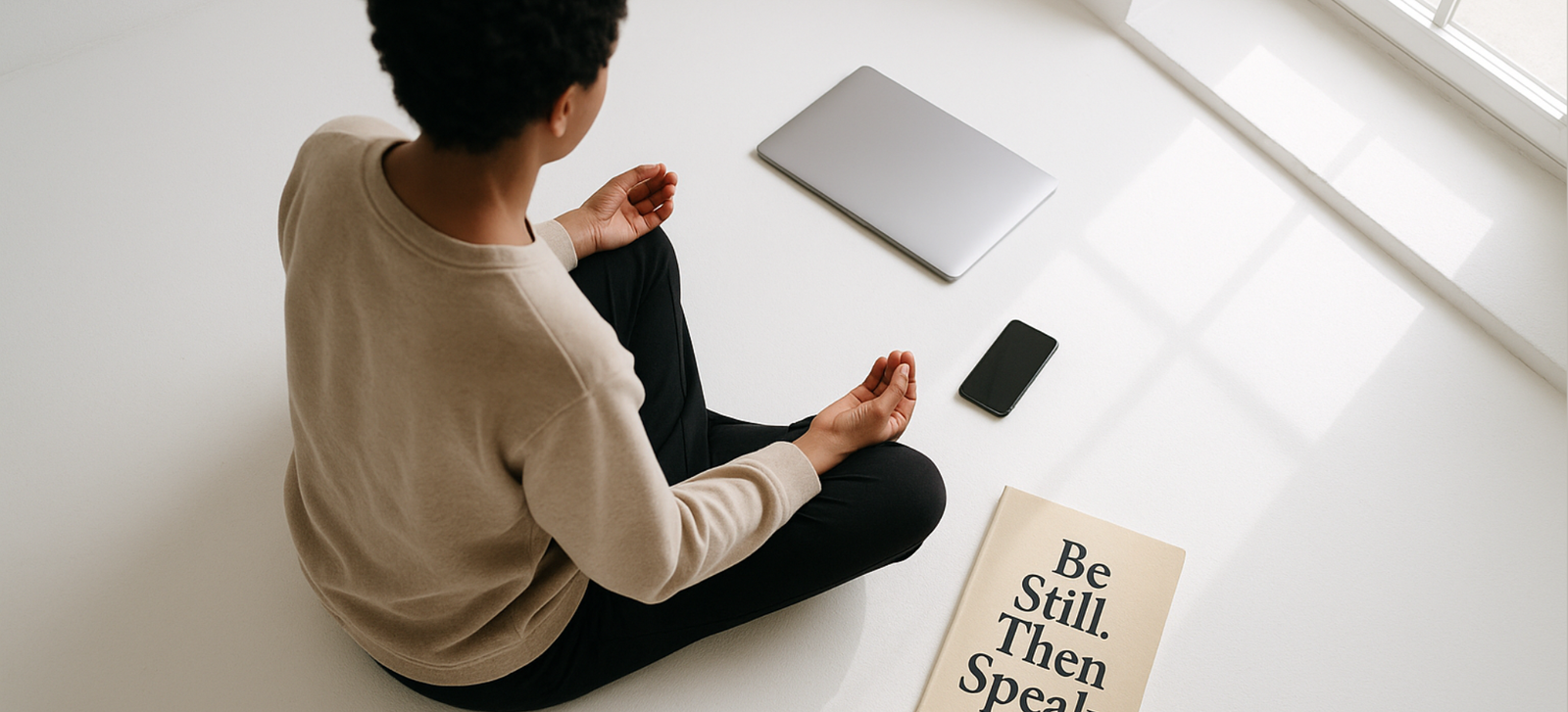A raw exploration of how stepping away from the digital din revealed what actually moves people—and transformed how I approach brand building.
The Day I Chose Silence
This wasn’t a digital detox or social media break. I committed to 30 days of complete silence at a retreat—no phone, no conversation, no eye contact. Just me and the relentless chatter in my own mind.
What surprised me wasn’t the peace that eventually came. It was what emerged first: every marketing message I’d ever crafted, every brand voice I’d developed, every campaign that had consumed my thoughts. Marketing wasn’t just my profession—it had become my mental operating system.
When Quiet Reveals the Chaos
Around day five, after wrestling with the usual suspects (anxiety, boredom, that embarrassing thing I said in 2019), something shifted. I started catching myself in real-time mental habits that would have been invisible in my normal noise-filled life.
Like how I automatically categorized a beautiful sunrise as “great for Instagram Stories.” How I found myself mentally crafting LinkedIn posts about being present while literally not being present. The irony was thick enough to cut with a butter knife.
I realized I’d developed what I now call “Content Creator Brain”—that constant background process scanning for marketable moments. Every conversation became potential testimonial material. Every struggle became a case study. Every insight became a post hook.
Sound familiar?
We’ve trained ourselves to live in permanent performance mode. We’re not just consuming content—we’re mentally producing it 24/7. The line between living and creating content about living has blurred beyond recognition.
Here’s the uncomfortable truth: I wasn’t the only one stuck in this loop. Every entrepreneur, creator, and business owner I knew was trapped in the same hamster wheel of content creation. We’d convinced ourselves this was “building our brand,” but really? We were just adding to the digital pollution.
But silence? Silence doesn’t optimize for engagement. It doesn’t split-test emotions. In that space, I discovered that real connection doesn’t need clever hooks—it needs genuine human truth.
Finding Signal in the Static
When your mind finally quiets—really quiets—something miraculous happens. You develop what I call “authenticity radar.” You can sense the difference between content that comes from genuine insight versus content that comes from the need to post something, anything, to feed the algorithm.
I started noticing how certain marketing messages made me feel physically uncomfortable. Those urgent “LAST CHANCE” emails. The fake scarcity tactics. The manipulative storytelling designed to trigger immediate action rather than build real relationships.
Here’s what hit me like a meditation pillow to the face: We’ve become so focused on the psychology of persuasion that we’ve forgotten the psychology of connection.
Real connection happens when someone feels seen, understood, and valued—not when they feel pressured, manipulated, or sold to. Yet somehow, we’ve built entire marketing strategies around the latter.
The question that rewrote my entire approach wasn’t just “Would I create this if no one engaged?” It was deeper: “Does this honor the person receiving it?”
That single question eliminated 80% of the marketing tactics I’d been using. The aggressive follow-ups. The fear-based messaging. The artificial urgency. All of it felt gross when viewed through the lens of genuine respect for another human being.
Less Is More Powerful
Coming back to civilization after 30 days of silence was like walking into a casino after spending a month in a library. Everything felt aggressively loud, desperately attention-seeking, and utterly exhausting.
I opened my laptop to find 47 drafted posts in my content calendar. Reading through them felt like looking at someone else’s work. Half were just variations of the same insight, dressed up in different hooks. The other half were trying so hard to be clever that they’d forgotten to be helpful.
I deleted 23 of them.
Not because they were poorly written—they weren’t. They were strategically sound, keyword-optimized, and designed to perform well. But they lacked something fundamental: a reason to exist beyond filling a content quota.
This is where most of us get it wrong. We mistake activity for effectiveness. We confuse posting frequency with brand building. We think more content equals more connection, but often it’s the opposite.
The brands I remember and respect don’t overwhelm me—they understand me.
They show up with intention, not just consistency. They speak when they have something worth saying, not just because the content calendar demands it. They trust that quality creates its own reach, that depth builds longer-lasting relationships than breadth ever could.
What Silence Taught Me About Brand Building
These principles now guide everything I create:
Quality over quantity. If it doesn’t add genuine value, it’s noise.
Respect attention. People’s time is sacred. Treat it that way.
Choose authenticity over optimization. Real connection beats clever manipulation.
Embrace brevity. Say what matters. Skip the rest.
Use space intentionally. Silence is part of your message.
Your 30-Minute Reset
You don’t need a month-long retreat. Try this: Close your browser tabs. Silence your phone. Sit with your brand for 30 minutes and ask:
- Does this feel authentic to who I am?
- Does this serve my audience meaningfully?
- Am I adding value or just adding volume?
If the answer is no, let it go.
The Power of Purposeful Pause
Marketing is powerful, but power without intention is just pressure. To build brands that endure and connect authentically, we need to integrate silence into our strategy.
In a world of constant content creation, the voice that whispers truth often speaks loudest.
Want more insights on building authentic brands? Subscribe to thoughtful marketing perspectives that prioritize depth over noise.


Leave a Reply